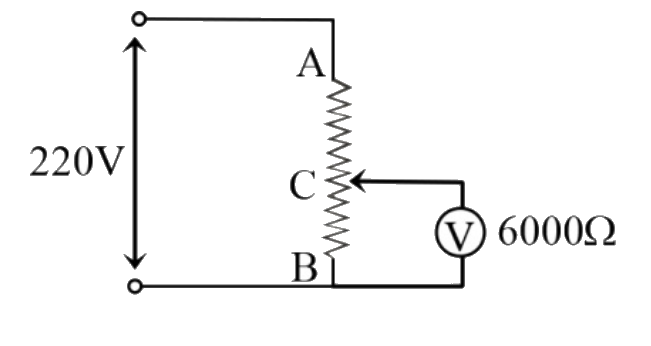A voltmeter has resistance 2000Ω and range 5 V. For increasing its range upto 20V, a resistance of
8000Ω should be connected in series.
6000Ω should be connected in series.
8000Ω should be connected in parallel
6000Ω should be connected in parallel.
The correct Answer is:2
To solve the problem of increasing the range of a voltmeter from 5V to 20V by adding a resistance, we can follow these steps:
Step 1: Understand the given values
- The resistance of the voltmeter (R) is given as 2000Ω.
- The initial range of the voltmeter is 5V.
- We want to increase the range to 20V.
Step 2: Determine the current through the voltmeter
The current through the voltmeter when it reads 5V can be calculated using Ohm's law:
IG=VR=5V2000Ω=52000=0.0025A
Step 3: Set up the equation for the new range
To find the new resistance Rs needed to achieve a range of 20V, we use the formula:
V=IG×Rs
Where V is the new voltage range (20V) and IG is the current through the voltmeter.
Step 4: Substitute the known values into the equation
We already calculated IG as 0.0025A. Now we can substitute V=20V into the equation:
20=0.0025×Rs
Step 5: Solve for Rs
Rearranging the equation gives:
Rs=200.0025=8000Ω
Step 6: Conclusion
The resistance that needs to be added in series to increase the range of the voltmeter to 20V is 8000Ω.
Final Answer:
The resistance required to increase the range of the voltmeter to 20V is 8000Ω.
---
- The resistance of the voltmeter (R) is given as 2000Ω.
- The initial range of the voltmeter is 5V.
- We want to increase the range to 20V.
The current through the voltmeter when it reads 5V can be calculated using Ohm's law:
IG=VR=5V2000Ω=52000=0.0025A
To find the new resistance Rs needed to achieve a range of 20V, we use the formula:
V=IG×Rs
Where V is the new voltage range (20V) and IG is the current through the voltmeter.
We already calculated IG as 0.0025A. Now we can substitute V=20V into the equation:
20=0.0025×Rs
Rearranging the equation gives:
Rs=200.0025=8000Ω
The resistance that needs to be added in series to increase the range of the voltmeter to 20V is 8000Ω.
The resistance required to increase the range of the voltmeter to 20V is 8000Ω.
Topper's Solved these Questions
- CURRENT ELECTRICITYBOOK - AAKASH INSTITUTE ENGLISHCHAPTER - CURRENT ELECTRICITYEXERCISE - ASSIGNMENT SECTION-C(OBJECTIVE TYPE QUESTION ))
13 Videos
- CURRENT ELECTRICITYBOOK - AAKASH INSTITUTE ENGLISHCHAPTER - CURRENT ELECTRICITYEXERCISE - ASSIGNMENT SECTION-D( LINKED COMPREHENSION TYPE QUESTIONS)
3 Videos
- CURRENT ELECTRICITYBOOK - AAKASH INSTITUTE ENGLISHCHAPTER - CURRENT ELECTRICITYEXERCISE - ASSIGNMENT(SECTION-A(OBJECTIVE TYPE QUESTIONS))
69 Videos
- COMMUNICATION SYSTEMS BOOK - AAKASH INSTITUTE ENGLISHCHAPTER - COMMUNICATION SYSTEMS EXERCISE - ASSIGNMENT SECTION D (Assertion-Reason)
10 Videos
- DUAL NATURE OF RADIATION AND MATTER BOOK - AAKASH INSTITUTE ENGLISHCHAPTER - DUAL NATURE OF RADIATION AND MATTER EXERCISE - ASSIGNMENT (SECTION-D)
10 Videos
Similar Questions
When a resistance of 100Ω is connected in series with a galvanometer of resistance R, then its range is V. To double its range, a resistance of 1000Ω is connected in series. Find the value of R.
View SolutionA galvenometer has a resistance of 50Ω and its full-scale deflection current is 50μA. What resistance should be added to it so that it can have a range of 0−5V?
View Solution
Knowledge Check
When a resistance of 100Ω is connected in series with a galvanometer of resistance R, then its range is V. To double its range, a resistance of 1000Ω is connected in series. Find the value of R.
A1100B1000C900D800
A potential difference of 220 V is applied across a rheostat of 12000Ω. The voltmeter V has a resistance of 6000Ω and distance BC is one - fourth of the distance from A to B. The error in the reading of voltmeter is approximately -

View SolutionA voltmeter has a resistance G and range V. Calculate the resistance to be used in series with it to extend its range to nV.
View SolutionA voltmeter has a resistance G and range V. Calculate the resistance to be used in series with it to extend its range to nV.
View SolutionA DC ammeter has resistance 0.1Ω and its current ranges 0−100A. If the range is to be extended to 0−500, then the following shunt resistance will be required
View SolutionTo reduce the range of voltmeter, its resistance need to be reduced.A voltmeter has resistance R0 and range V. Which of the following resistance when connectyed in parallel will convert it into a voltmeter of range V//n?
View SolutionA potential difference of 22V is maintained across a 1200Ω rheostat PR. The voltmeter has a resistance of 600Ω and PQ is one fourth of distance from P to R. What is the reading ( in V ) of the voltmeter ?

View SolutionA galvanometer coil has a resistance 90Ω and full scale deflection current 10mA. A 910Ω resistance is connected in series with the galvanometer to make a voltmeter. If the least count of the voltmeter is 0.1V the number of divisions on its scale is
View Solution
